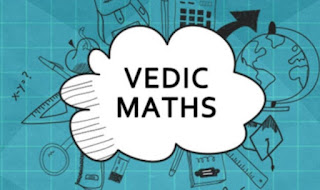VEDIC MATHS-64
VEDIC MATHS
By OMKAR TENDOLKAR
This is post number 64 from the series of "Vedic maths" blogs. Here in this blog we will learn about "The concept of Negative Osculator"
Concept of Osculator :
The concept of ‘Osculator’ is useful to check the divisibility of a given number by divisors ending with 9 or 1 or a multiple there of.
An osculator is a number defined for any number ending in 9 or 1 and is obtained from the number by a simple mechanism described in this chapter.
The use of Osculators would be severely limited if only these two categories of numbers viz. ending with 9 or 1 were considered. Interestingly, numbers ending with 3 and 7 can also converted to numbers ending with 1 or 9 by a suitable multiplication. The same techniques can be used for all such numbers too.
Osculators are categorized into two main types viz. positive and negative depending on whether the number ends with 9 or with 1.
- Dropping 1
- Remaining number is Negative Osculator
Examples :
Compute the Negative Osculators for various numbers.
1. 21
- Dropping 1
- Remaining digit is Negative Osculator i.e 2.
2. 51
- Dropping 1
- Remaining digit is Negative Osculator i.e 5
3. 81
- Dropping 1
- Remaining digit is Negative Osculator i.e 8
4. 7
- Here, given number 7 end with 7, we can multiply it by 3, to convert it to a number which ends in 1 i.e. 21.
- Dropping 1
- Remaining digit is Negative Osculator i.e 2
5. 9
- Here, given number 9 end with 9, we can multiply it by 9, to convert it to a number which ends in 1 i.e. 81.
- Dropping 1
- Remaining digit is Negative Osculator i.e 8
6. 17
- Here, given number 17 end with 7, we can multiply it by 3, to convert it to a number which ends in 1 i.e. 51.
- Dropping 5
- Remaining digit is Negative Osculator i.e. 5.
7. 23
- Here, given number 23 end with 3, we can multiply it by 7, to convert it to a number which ends in 1 i.e.161.
- Dropping 1
- Remaining digit is Negative Osculator i.e 16.
- 69 Ans Osculator of 69 is 62.
- 39 Ans Osculator of 39 is 35.
- 23 Ans Osculator of 23 is 16.
- 37 Ans Osculator of 37 is 11.
- 11 Ans Osculator of 11 is 01.
In next blog we will discuss about "The Osculation Method for checking divisibility of number by Negative Osculator".
We will meet very soon through our next blog. Till that stay connected, stay healthy and stay safe.
Thanks
for giving your valuable time.


Negative osculator of 11 is 1 instead of 2as mentioned.
ReplyDeleteOhh thank I will re correct it...
Delete